King of Saudi Arabia
The king of Saudi Arabia is the monarchial head of state and head of government of Saudi Arabia who holds absolute power. He is the head of the Saudi Arabian royal family, the House of Saud.[1] The king is called the "Custodian of the Two Holy Mosques" (خادم الحرمين الشريفين), a title that signifies Saudi Arabia's jurisdiction over the mosques of Masjid al Haram in Mecca and Al-Masjid an-Nabawi in Medina, the title has been used many times through the history of Islam. The first Saudi monarch to use the title was King Faisal, however, King Khaled did not use the title after him. In 1986, King Fahd replaced "His Majesty" with the title of Custodian of the Two Holy Mosques, and it has been ever since used by both King Abdullah and King Salman bin Abdulaziz.[2]
| King of Saudi Arabia | |
|---|---|
| ملك المملكة العربية السعودية | |
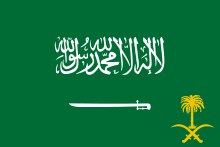 Royal Standard of Saudi Arabia | |
| Incumbent | |
_(cropped).jpg) | |
| Salman bin Abdulaziz Al Saud Custodian of the Two Holy Mosques since 23 January 2015 | |
| Details | |
| Style | Custodian of the Two Holy Mosques (formal) or His Majesty (diplomatic relations) |
| Heir apparent | Mohammed bin Salman |
| First monarch | Ibn Saud |
| Formation | 22 September 1932 |
| Residence | Al-Yamamah Palace |
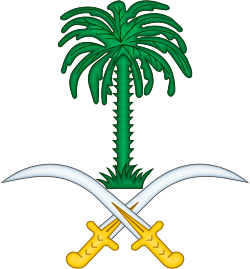 |
|---|
| This article is part of a series on the politics and government of Saudi Arabia |
|
|
| Basic Law |
|
|
Administrative divisions
|
|
|
|
History
King Abdulaziz (known in the West as Ibn Saud) regained his patrimony, which is known as today's Saudi Arabia in 1902. Restoring his family as emirs of Riyadh, he then established Nejd as his headquarters in 1922. Following the establishment of Riyadh as the capital of his state, King Abdulaziz then captured Hejaz 1925.[3]
Ibn Saud proclaimed his dominions as the Sultanate of Nejd in 1921, shortly before completing the unification of the region. He was proclaimed king/malik of Hejaz in 1926, and raised Nejd to a kingdom as well in 1927. For the next five years, Ibn Saud administered the two parts of his realm as separate units. In 23 September 1932, he formally united his territories into the Kingdom of Saudi Arabia.[4][5]
Succession
The kings since Ibn Saud's death have all been his sons, and all likely immediate successors to the reigning King Salman will be from among his progeny. Sons of Ibn Saud are considered to have primary claim on the throne of Saudi Arabia.[6] This makes the Saudi monarchy quite distinct from Western monarchies, which usually feature large, clearly defined royal families and orders of succession, and use the absolute primogeniture system of succession. Muhammad bin Nayef was the first grandson of Ibn Saud to be in the line of succession before being deposed from the position of Crown Prince by a royal decree in 2017.[7]
Legal position
Saudi Arabia is ruled by Islamic law (Sharia) and is an Islamic state.[8]
Other functions
The king of Saudi Arabia is also considered the head of the House of Saud and prime minister. The crown prince is also the "deputy prime minister". The kings after Faisal have named a "second deputy prime minister" as the subsequent heir after the crown prince.
Royal Standard
The Royal Standard consists of a green flag, with an Arabic inscription and a sword featured in white, and with the national emblem embroidered in gold in the lower right canton.[9]
The script on the flag is written in the Thuluth script. It is the shahada or Islamic declaration of faith:
List of kings of Saudi Arabia (1932–present)
| Name | Lifespan | Reign start | Reign end | Notes | Family | Image |
|---|---|---|---|---|---|---|
Ibn Saud
| 15 January 1875 – 9 November 1953 (aged 78) | 22 September 1932 (aged 57) | 9 November 1953 (death by natural causes) | Reign established by conquest | Saud | 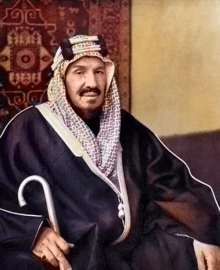 |
Saud
| 12 January 1902 – 23 February 1969 (aged 67) | 9 November 1953 (aged 51) | 2 November 1964 (abdicated) | Son of Ibn Saud and Wadhah bint Muhammad bin 'Aqab | Saud | 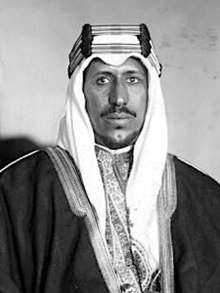 |
Faisal
| 14 April 1906 – 25 March 1975 (aged 68) | 2 November 1964 (aged 58) | 25 March 1975 (assassinated) | Son of Ibn Saud and Tarfa bint Abduallah bin Abdulateef al Sheekh | Saud | .jpg) |
Khalid
| 13 February 1913 – 13 June 1982 (aged 69) | 25 March 1975 (aged 62) | 13 June 1982 | Son of Ibn Saud and Al Jawhara bint Musaed bin Jiluwi | Saud |  |
Fahd
| 16 March 1921 – 1 August 2005 (aged 84) | 13 June 1982 (aged 61) | 1 August 2005 | Son of Ibn Saud and Hussa bint Ahmed Al Sudairi | Saud | 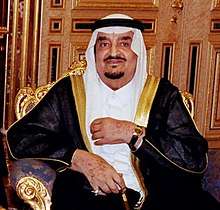 |
Abdullah
| 1 August 1924 – 23 January 2015 (aged 90) | 1 August 2005 (aged 81) | 23 January 2015 | Son of Ibn Saud and Fahda bint Asi Al Shuraim | Saud |  |
Salman
| 31 December 1935 | 23 January 2015 (aged 79) | Incumbent | Son of Ibn Saud and Hussa bint Ahmed Al Sudairi | Saud | _(cropped).jpg) |
Current heirs-presumptive
- Crown Prince: Mohammad bin Salman, born 31 August 1985; son of King Salman and Fahda bint Falah bin Sultan Al Hithalayn.[11]
Timeline

See also
References
- "Saudi Arabia - Government and society". Encyclopedia Britannica. Retrieved 26 July 2020.
- "Story behind the king's title". Arab News. 27 January 2015. Retrieved 26 July 2020.
- "History | The Embassy of The Kingdom of Saudi Arabia". www.saudiembassy.net. Retrieved 26 July 2020.
- "About Saudi Arabia". UNDP in Saudi Arabia. Retrieved 26 July 2020.
- "History of Saudi Arabia. ( The Saudi National Day 23, Sep )". www.pmu.edu.sa. Retrieved 26 July 2020.
- "Governance and Politics of Saudi Arabia". Fanack.com. Retrieved 26 July 2020.
- "Mohammed bin Salman becomes Saudi Crown Prince with 31 out of 34 votes". Al Arabiya English. 21 June 2017. Retrieved 26 July 2020.
- Rabasa, Angel (2004). The Muslim world after 9/11. Rand Corporation. p. 164. ISBN 978-0-8330-3712-1. Archived from the original on 11 February 2017. Retrieved 16 May 2016.
- "Royal Standard (Saudi Arabia)". www.crwflags.com. Retrieved 28 July 2020.
- "About Saudi Arabia: Facts and figures". The Royal Embassy of Saudi Arabia, Washington D.C. Archived from the original on 17 April 2012. Retrieved 24 April 2012.
- "Who is Saudi Crown Prince Mohammed?". BBC News. 22 October 2018. Retrieved 28 July 2020.